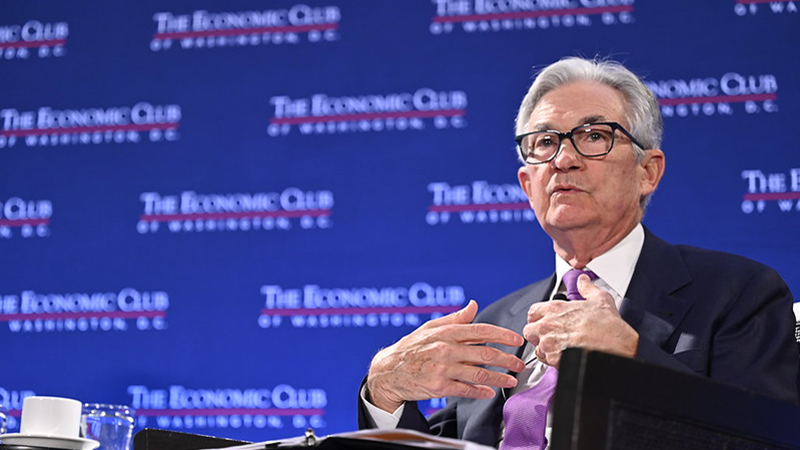While the banking turmoil now appears to have calmed, it has created further disruption to interest rate expectations. The market expects that it will curb further rate rises because of the likely impact on bank lending and therefore economic growth. However, the central banks are giving no ground, saying ongoing inflationary pressures allow no pivot on rates in the near term.
This means there is real disparity between the market’s view and central banks’ view of when the rate cycle turns. This is particularly acute in the US where the market is anticipating a rate cut in the US as early as July and around 100bps of cuts by the end of the year. In contrast, the Federal Reserve ‘dot plot’ has barely moved since December, in spite of stronger news on the economy.
Who is right? The market’s view shifted significantly after the banking turmoil, suggesting it is being driven by the likely tightening in credit conditions as banks rein in lending. That view has evidence to support it. Data from the Federal Reserve shows that banks were already tightening credit conditions for small firms.
Steven Bell, chief economist at Columbia Threadneedle, says: “A very significant tightening was already happening in January, well before the latest problems in small and medium-sized banks in the US. They were already tightening to levels not seen since the global financial crisis. The next set of numbers – released at the start of May – are going to be much higher.” In Europe, he says, the problem is not as severe. Nevertheless, investors take their lead from the Federal Reserve.
Inflation numbers yet to reflect tightness of conditions
On the flip side, inflation expectations are still stubbornly high. Economic data since the start of the year has been stronger than expected in spite of central bank tightening. Inflation expectations have dropped a little bit, but not significantly. The recent data from Europe and the UK suggests that inflation is stickier than previously expected and not yet under control even as commodity prices fall. Central banks continue to forecast lower inflation for the second half of the year, but few have managed to predict the trajectory of inflation with any reliability.
Labour markets are still strong and consumer confidence is relatively buoyant. In the US, consumer confidence is high. In Europe and the UK, it is picking up significantly from depressed levels. February retail sales in the UK showed a surprise bounce of 1.2%, led by discount and second-hand stores. Bell points to the still-unspent Covid piggy banks in the UK and Europe, which should act to support spending for near term. All this is likely to be inflationary.
Alex Funk, chief investment officer at Schroders Investment Solutions, says: “Public enemy number one is inflation. How do we get to the end of that inflation cycle? How do we prove that inflation is consistently rolling over? The only thing central banks have to combat that is interest rates. They are pushing rates up, hoping they slow down just enough and can accelerate from there.” He believes the banking turmoil forced central banks to accept that higher rates had “broken something” and that the peak in rates may be lower than before, but where the peak comes is still unclear.
“The market is trying to look for where interest rates peak, where they are high enough to slowdown the economy. The goods side has come down, but it’s the services side that is creating problems – we’re still going out, we’re still going on holiday, we’re still making up for lost time. Service spending is high and sticky. That creates a problem.”
Growth versus value conundrum
This matters for stock markets because it means everything is on pause. Until there is clarity on interest rates, a holding pattern is likely to prevail. It is difficult to know whether to skew a portfolio for value or growth. Value strategies look compelling from a relative valuation point of view, but tend to have high weightings in banks and natural resources. Banks are in turmoil and commodity prices are falling. Growth has rallied since the start of the year as interest rate expectations have fallen, but still looks vulnerable if monetary policy turns.
Experience of previous recessions should also give investors pause for thought. Schroders strategist Tina Wong says: “With equities typically in the red during recessions, the most defensive sectors in the US, such as consumer staples and healthcare have on average delivered the strongest returns. This is because investors have looked for companies that offer superior profitability and robust balance sheets during times of economic stress. Instead, the more cyclical areas of the market such as financials and industrials have tended to be the worst performers.”
But she adds that investors may miss the bounce if they focus too exclusively on ‘defensive’ parts of the market. Smaller companies in particular can bounce very quickly in the latter stages of a recession as investors start to discount the recovery in corporate profitability and the impact of lower interest rates.
Funk says that quality can be a refuge in this environment – that means companies with strong cash flow generation, strong and tangible assets and good dividends. Jennifer Fisher, head of equities at Waverton agrees, adding: “We try to make reasonable assumptions about the outlook without being tied to one outcome. We’re assuming higher rates for longer and that inflation will come down more slowly. We’re in a trading range for the moment. We’re trying not to jump on short-term trends, to remain long-term in our perspective, however uncomfortable.
“Markets have been thrown around by the macro date and what’s been happening in bond markets, which has been extraordinary. What we find is that equity markets trade on the back of that until we come to earnings season.”
Investors have a waiting game ahead. Markets remain minutely focused on interest rates, but there remains little clarity on when that peak will arrive and whether the market or central banks have correctly diagnosed the outlook. In the meantime, taking binary positions on markets looks like a hazardous option.









